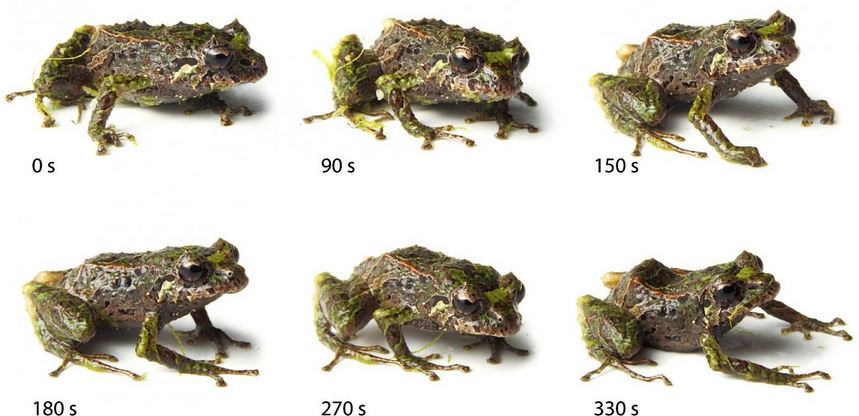An amazing shape shifting frog that grows spikes when it is on a surface with moss and changes to a smooth-textured skin when it moves onto a smooth surface, has been discovered in Ecuador’s Andean cloud forest.
While not having the super shape-shifting abilities of the Body Snatchers or being able to turn into a pool of liquid like some Star Trek aliens, what this little frog can do it still amazing.
The new species, called the Mutable Rainfrog (Pristimantis mutabilis), was discovered by Case Western Reserve University PhD student Katherine Krynak and her husband Tim Krynak, manager at Cleveland Metroparks’ Natural Resources Division. They thought it was the first species able to shape shift, but it also has a cousin that can do the same.

See how Pristimantis mutabilis changes in just 330 seconds from a spiky to smooth skinned creature. (Image: Zoological Journal of the Linnean Society)
Researchers working with Mr. and Mrs. Krynak recently found a known relative of the frog that can also change the texture of its skin. They simply had not reported it.
Reserva Las Gralarias
The frogs were found at Reserva Las Gralarias, a 1,063-acre wildlife sanctuary, protecting cloud forest, rivers, creeks, watersheds, and home to hundreds of species of birds and other animals, orchids, bromeliads, ferns, ancient trees.
The Krynaks helped form the Las Gralarias Foundation, whose aim is to support the conservation efforts of the reserve.
The researchers, along with a team from the Universidad Indoamérica and Tropical Herpin (Ecuador), wrote about their findings in the academic journal Zoological Journal of the Linnean Society.
The authors say their discovery has broad implications for how species are and have been identified. Taxonomy (classification of organisms) may now require photographs and perhaps longer-lasting observations in the field to make sure that one species is not classed as two because of a creature’s ability to change how it looks.
Shape-shifting probably a survival trait
Mrs. Krynak suggests that P. mutabilis changes skin texture as a camouflage survival strategy to protect itself from birds and other possible predators.
The Krynaks first came across the small, prickly frog, almost the width of a marble, in July 2009. It was sitting on a moss-covered leaf about three feet off the ground during a misty evening.
Even though they had both been to Las Gralarias several times, neither of them had ever seen this creature before.
They captured the little animal and placed it in a cup with a lid before carrying on searching for wildlife. It was dubbed “punk rocker” because of the thorn-like spines that covered its whole body.
Next morning, Mrs. Krynak took the frog from the cup and placed it on a smooth white sheet of plastic so that her husband could photograph it.

These six photographs show how Pristimantis mutabilis’ skin changes during the 330 seconds. (Image: Zoological Journal of the Linnean Society)
When they looked at it they were dismayed and wondered whether they had picked up the wrong one. Gone were those punk-style spikes, to be replaced by perfectly smooth skin.
Mrs. Krynak said:
“I then put the frog back in the cup and added some moss. The spines came back… we simply couldn’t believe our eyes, our frog changed skin texture! I put the frog back on the smooth white background. Its skin became smooth.”
“The spines and coloration help them blend into mossy habitats, making it hard for us to see them. But whether the texture really helps them elude predators still needs to be tested.”
Skin texture changes rapidly
Over the next three years a team of biologists continued studying P. mutabilis. They reported that the animal is able to completely change its skin texture in just 330 seconds.
First author, Juan M. Guayasamin, from Universidad Tecnológica Indoamérica, Ecuador, carried out morphological and genetic analyses, and found that P. mutabilis was a unique and undescribed species.
Co-author Carl R. Hutter, who works at the University of Kansas, studied the frog’s calls and identified three utterances it uses which differentiate it from relatives.
Co-author Jaimie Culebras, a member of Tropical Herping, who helped out with fieldwork, located a second population of the species. Tropical Herping is a specialized company devoted exclusively to herping (searching for amphibians or reptiles) trips and herpetography workshops in Ecuador and the tropics.
Mr. Guayasamin and Mr. Hutter found that the larger cousin Prismantis sobetes, which is about twice the size of P. mutabilis, can do the same thing with its skin. So far, this is the only relative that has been tested.
The appearance of animals has long been one of the keys to identifying their species. The authors believe their find “challenges the system, particularly for species identified by one or just a few preserved specimens.”
In the case of P. mutabilis and P. sobetes, there was no way of knowing whether the appearance was changeable.
The Krynaks say they plan to return to the nature reserve, and along with fellow scientists to further document the mutable rain frogs’ behaviors, texture shifting, lifecycle, and estimate their population. The aim being to improve our knowledge and subsequent ability to conserve this amazing species.
They also want to find out whether P. mutabilis has other relatives with shape-shifting abilities, and whether that trait comes from a common ancestor. If these two species are the only ones within this branch of Pristimantis frogs to be able to shape shift, they hope to learn whether they inherited this trait from an ancestor, or developed it during their evolution independently.
Citation: “Phenotypic plasticity raises questions for taxonomically important traits: a remarkable new Andean rainfrog (Pristimantis) with the ability to change skin texture,” Juan M. Guayasamin, Tim Krynak, Katherine Krynak, Jaime Culebras and Carl R. Hutter. Zoological Journal of the Linnean Society. Published on 24 March 2015. DOI: 10.1111/zoj.12222.
Video – Shape-shifting frog
